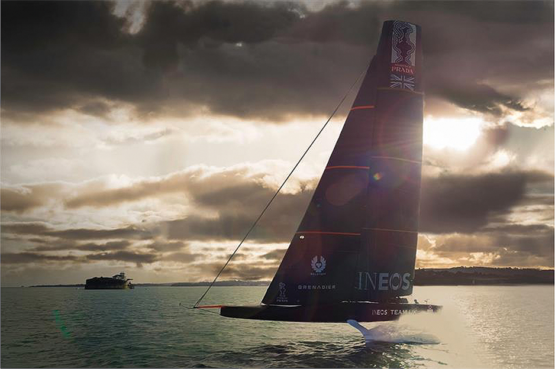By Stuart Doe, Head of Active Solutions, Fischer Connectors
High-end racing, whether on land or water, is notorious for its secrecy. With the Prada Cup and America’s Cup races in 2021, no one working with any of the hyper-competitive teams would dare give away those secrets.
Spoiler alert: This isn’t about secrets. Even though Fischer Connectors is the exclusive connectivity sponsor of American Magic – a challenger for the 36th America’s Cup – and has provided connectors and solutions for many racing yachts over the past five decades, we can’t give away any of our trusted partners’ competitive secrets. This article is about the lessons learned working on various racing yachts over time, and how some of the latest connector technology and strategies used in racing can be applied to other real-world applications.
Racing into 2021
From the moment the America’s Cup AC75 class rule was first published on March 29, 2018 by the current America’s Cup Defender, Emirates Team New Zealand, challenger teams have been designing and engineering their boats within the set rules to give them every possible edge in a temperamental racing environment. In fact, American Magic spent over 76,000 man hours producing its first AC75, DEFIANT.
So, what are the stats for an AC75?
· Length: 22.76 m
· Width: 5 m
· Weight 6.4 tons
· Crew: 11
· Crew weight: 990 kilos
· Construction: carbon fiber and double-skinned soft wingsail
· Construction hours: 76,000+
· Design hours: 90,000+
· CNC machine and/or 3D printing hours: 45,000
· Individual parts: 25,000
· Sensors: 300+
All of this development comes at a significant cost to the teams entering the America’s Cup. To put this into context, the last event in 2017, held in Bermuda and won by Emirates Team New Zealand, is believed to have cost upwards of USD 100 million, with some teams reporting that they had to pay twice this figure to actually become competitive for the Cup.
Races can be won or lost in the design, construction, and/or operational phases. Even fractions of seconds are of critical importance in a race for the America’s Cup and for the pride of a nation. Despite huge R&D budgets, it’s ultimately the team of 11 sailors working as one in precise harmony that determines who’ll be the winners on race day. So, the engineering teams do everything they can to give their sailors the advantage.
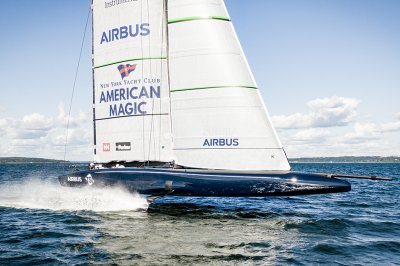
Electronics play a key role in crossing the finish line first, especially when dealing with ever-changing wind and wave conditions. Fischer Connectors is the exclusive connectivity sponsor for American Magic, Challenger for the 36th America’s Cup. Copyright: Amory Ross / NYYC American Magic
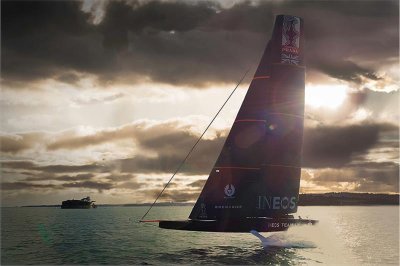
Racing yachts such as the UK Team Ineos’ “Britannia” are estimated to have over 300 sensors on board to help guide sailors by giving race teams real-time data on changing conditions. Copyright: Chris Ison
Lesson One: Sensors Create Real-Time Data for Immediate Decision Making
Sailors and their support teams operating in high-pressure situations have to deal with many more variables than, say, the driver of a “simple” NASCAR vehicle. Wind speed and direction, water movement, water temperature, hull angle and foil position are all variables in yacht racing that can not only affect each vessel differently, but also change constantly during the race. Sensors are everywhere on the boat, from the foils to the wingsail, gathering data that enable sailors to calculate and use them to their advantage. Additionally, sensors help to adjust strategies or tactics in a fraction of a second if they get the right information at the opportune moment.
Given the strict weight criteria for such a “flying machine”, designers and engineers are constantly deliberating over each component used on the vessel: Will it deliver during practice, during the race, once or over time? Is it rugged enough? Is it too heavy? Is it really needed?
The Importance of Interconnect Solutions
Reliability in both the sensors and connector solutions is essential. Maintainability is critical, as is IP (Ingress Protection) sealing and the ability to withstand saltwater ingress and spray.
Elevated temperatures are also a challenge to connector solutions, as most electronics are stored (and operated) in sealed airless compartments and may be exposed to extreme solar heating. Indeed, a black carbon panel can easily reach above 70°C in the UK sunshine – let alone in New Zealand! This places significant duress on the reliability and functionality of the electronics enclosed within.
Fiber Optic Plays an Important Role
One area of great interest beyond the use of conventional copper wired interconnect solutions is the use of fiber optics for data transmission. In the America’s Cup in 2017, which introduced foiling for the first time, fiber optic sensors were embedded in the race boat foils. This allowed the team to measure, analyze, predict and optimize the foil blade rake i.e., the angle of the foils to the water, along with foil stress. If set correctly, the foil offers both lift and drag, similar to an aircraft wing in flight.
“The electronics and data acquisition on an America’s Cup yacht such as American Magic’s Defiant are absolutely crucial to our success,” says Antoine Sigg, Fiber Optic Manager at NYYC American Magic. “Loads of data streams are processed constantly, feed models, trigger alarms and help the sailor to make adjustments for wind, attitude and stresses on the boat. It’s essential that the connectivity solution delivers accurate data. The fiber optic solutions from Fischer Connectors help us in many key zones on the boat.”
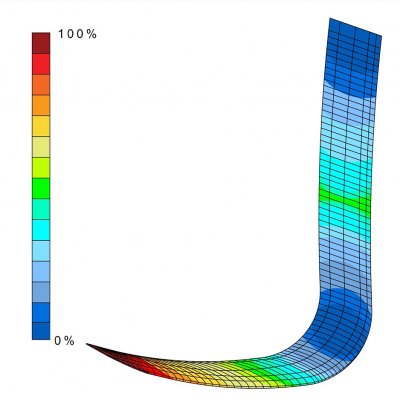
Fiber optic sensors embedded in race boat foils can be used to measure the lift, drag and horizontal force generated by the foil in real time. Image courtesy of Epsilon Optics www.epsilonoptics.com/marine.html. Fischer Connectors’ ruggedized optical connectors are used in the UK-based company’s latest sensor system.
In a racing yacht, the foil rake and angle of attack are adjusted for different points of sailing (upwind and downwind) and different wind strengths. Getting real-time information from the sensors through fiber optic connections allows optimization of the foil angle and load, providing the appropriate lift for any given displacement and wind condition.
This was demonstrated to greatest effect in the 2019 Sail GP event in Cowes on the UK’s Isle of Wight. There Tom Slingsby’s Australian Team utilized the foils in a completely different mode than any competitor, sailing three races with the bow firmly down, reducing the rudder loads, and maintaining control in winds of over 25 knots. The result was three straight wins over the remaining international competitors.
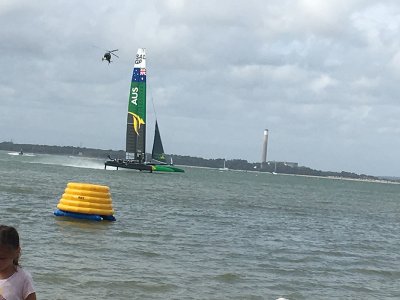
Catamarans in previous America’s Cup races may not have been the first to utilize “big data” during competitive sailing for real-time and post-race analysis, but they pushed ideas that led to today’s electronics designs. Copyright: Stuart Doe
Fiber optic devices tend to be smaller and lighter than conventional copper. The cable is essentially a glass tube less than 2 mm in diameter that propagates data using light energy, which is converted into an electrical signal at the destination source. In essence, data speeds move in near perfect conditions within the tube, resulting in the highest data transfer rates, without loss or low delay.
Another advantage of fiber optics is the ability to physically embed these miniature single-strand sensors into the laminated carbon structures of the boat, without affecting the structural integrity of the foil or mast/wing section or the functionality of the hardware. These embedded sensors also ensure you can monitor potential breakages of such highly stressed parts of the boat at all times and avoid them if at all possible. Clearly, these items are very asset-sensitive due to cost, material and build time; hence only the most appropriate cabling and connector systems can help ensure longevity and avoid delays in this challenging environment.
A final significant benefit for the AC75 is the weight advantage offered by this type of fiber optic. When considering electronics control systems on board boats, it’s fair to assume most yachts carry in excess of 60 kg of wire for their control and instrumentation circuits. This weight can be greatly reduced if traditional copper is replaced with state-of-the-art, high-capability fiber.
Data as a Commodity
As reported by Martin Whitmarsh, CEO of Land Rover BAR, with all this live real-time data from in excess of 400 sensors per boat*, it’s a veritable treasure trove of data. It’s essential that adequate data connection, onward transmission, storage and subsequent analysis be performed for all modes of sailing and conditions. As a dinghy sailor myself, I consider my surroundings and speed while sailing, just two variables that affect my performance. For these high-performance racing yachts, however, sailors consider up to an estimated 300 variables simultaneously to evaluate and adjust performance, including water time, flight time, speed, boat position, angle, loads, foils and rudder angle. To do this perfectly in a race requires gathering, transmitting, analyzing and acting on reliable data. In 2017, it was estimated that Team Oracle’s boat accumulated between 200 GB and 500 GB of data every day. It’s no wonder that so much data crunching is needed to ensure you can optimize the performance of every element for live sailing conditions. This explains the involvement of companies like database giants Oracle and Dell EMC in the last America’s Cup and, more recently, Hewlett Packard for this 2021 campaign. Clearly, reliable data management ensures the boat performs as competitively as possible and defines a clear configuration setup for each and every condition that the boat is raced in. Recent reports from the teams out in New Zealand suggest that the typical data now being collected by this year’s Cup teams are in excess of 1 billion data entry points. This makes the data collation and sifting activity a significant contribution to the teams’ performance and understanding of the data variables, with significant implications for performance.


